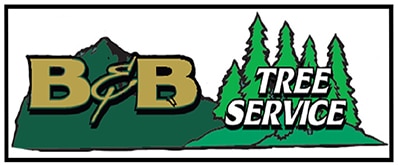At B&B Tree Service in Asheville, we have clients call us not because they want to have a tree removed but because they want to reduce the size of a tree. There are several reasons why you’d want to do this:
- It has outgrown the area it was planted in
- It’s blocking your view
- It’s touching powerlines
- It’s hitting your roof when the wind blows
They love the tree, they just want it smaller and ask us to “cut it back”. This practice is known as “topping” or “hat-racking”. We do not do this. Instead, we do what’s called “tree crown reduction and thinning.”
“Topping” and “hat-racking” are actually the most devastating pruning cut for a tree. In fact, it is the second most common cause of tree decline/death. ISA-certified arborists will not do this type of pruning because it is so damaging- and it’s irreversible.
Pruning trees is an exact science
In order to understand when, how, and where a tree should be pruned, our tree experts at B&B Tree Service are educated in the internal workings of trees and how they respond to wounds (pruning cuts) and how they grow.
Correct vs. Incorrect Pruning
Crown reduction involves pruning the tree’s crown. An experienced arborist precisely makes each cut as part of a big-picture pruning plan. This is the correct way to prune.
On the other hand, incorrect tree pruning reduces the size and appearance of your trees and doesn’t consider the tree’s stress response to wounds, branch structure, or growth habits. You end up with a tree that looks bad and responds by growing weak, spindly growth that will need to be pruned again in a year or so.
Tree Crown Reduction Explained
Tree crown reduction is the process of selectively pruning branches to reduce the overall size of the tree. This creates a shorter tree with a balanced branch structure. When you hire B&B Tree Service, you can be sure that we will maintain the natural form of the tree when we do tree crown reduction.
The best way to ensure your tree’s health and vigor is to hire a professional to do good crown reduction along with regular pruning. It’s important to note that proper crown reduction doesn’t remove more than 20% to 25% of the tree’s foliage/branches. For mature trees or those that are in decline or stressed, this should be even lower.
After all, pruning stimulates growth, which needs to be proportional to the tree’s stored energy reserves and vigor.
Branch Thinning Explained
Branch thinning is part of tree crown reduction and involves pruning selected branches to their origin point. This process opens up a dense tree, allowing light and air into the area, re-balancing the weight of the branches to influence future growth. Branch thinning is not always necessary. A certified arborist will know when this practice should or should not be used.
Proper Crown Reduction is Valuable
Tree crown reduction and branch thinning are practices that reduce the overall size of your trees without interfering with natural growth patterns and without creating issues in the future. It can help you save your larger, mature trees that have outgrown their area and are going onto your neighbor’s property, roadway, or power lines.
On the other hand, “hat-racking” or “topping” can create problems resulting in a tree that produces poorly attached branches that need to be removed, as well as an ideal habitat for insects and disease. This increases the maintenance costs of your tree and can ultimately result in decline and death.
A new young tree simply can’t replace the value lost by losing a mature tree.
Hire the Right Tree Service
In order to keep your trees healthy, make sure that you are tree experts that do not top trees. Also, you should never choose a tree service just because they are cheap- especially when none of their crew members are trained experts.
If you’re in or near Asheville, North Carolina, call the pros at B&B Tree Service. We understand the proper techniques for tree crown reduction and thinning.















